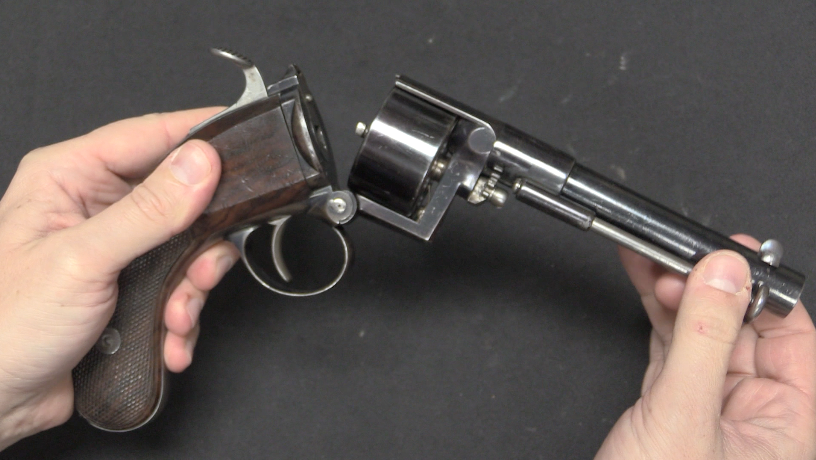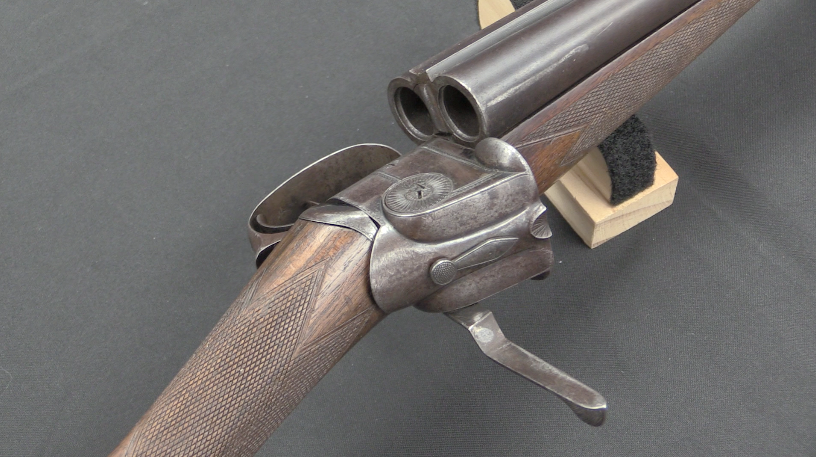I finally have a source for top quality reliable 7.65mm French Long, thanks to Steinel! I can’t link to them, but I’m sure anyone who wants some themselves can find them online. Anyway, with ammo now available, I decided to test out the French 1935A and 1935S pistols side by side. First slow fire at 10 yards for groups, then 30 yards at a steel plate, and then rapid fire at 5 yards.
Both of these pistols were formally adopted for French military use. The 1935A was first, designed by Charles Petter and made by SACM. When production was not sufficient to meet Army demand, the St Etienne design from the trials was also adopted and put into production. Both guns use the same cartridge, and both are Browning-type tilting barrel actions, but the mechanical similarities end there. Handling-wise they are quite similar, both using magazine release buttons and similar safety levers on the back of the slides.
The verdict for me from shooting both was that I prefer the 1935A. Its trigger was more predictable for me (although that may not be representative of all 35A and 35S examples), and I like the handling of the grip better.




Both this and the previous clip on the M1892 emphasize the pragmatic nature of French military selections = both relatively unexceptionable and somewhat old fashioned and lacking in power but eminently serviceable and notably easy to use – so perfect for them.
“(…)lacking in power(…)”
Cartridge was of small diameter not without reason. French acknowledged need for automatic pistol shortly after Great War. One of their requirements was capacity 10. Double-stack (staggered) magazine inside automatic pistol were virtually unknown. So they choose possible small diameter to allow possible multiple of cartridge in flat magazine without making grip hideously long. This resulted in MAS 1925 No. 1, see 49-10:
http://www.earmi.it/armi/atlas/271.htm
note relatively long grip to hold 10 rounds and tactile indicator of degree of loading of magazine (with markings: 0 5 10)
“French acknowledged need for automatic pistol shortly after Great War.”
While the Germans had had automatic pistols since 1908 in their armed forces, and the Americans since 1911.
We French have quite a knack for being late, it seems.
To be more precise I should say: own automatic pistol.
French used automatic pistols, but these were not one designed specifically for them – or using language of U.S. abbreviations-lovers: COTS = Commercial Off The Shelf. Namely STAR 1914. http://star-firearms.com/firearms/guns/pre1920/index.shtml
“(…)We French have quite a knack for being late, it seems.(…)”
Well, handguns are generally very low in priority of replacement. French 1892 offered, thanks to swing-out cylinder, relatively quick reload when compared to say Rast & Gasser 1898 revolver. As for French military in dawn of 20th century, they seem to actually show interest in technical innovations, among others Ministère de la Défense français was first of such Ministries to fund development of aeroplane, though it failed to work as intended – for short summary of this history, see: https://www.reddit.com/r/polandball/comments/56seuv/king_of_the_air/
and also show interest for tanks (or more precisely barbed-wire crusher) early, which lead to building and testing of this incredibly steam-punk looking Fortin Automobile ‘la Machine Boirault écrase barbelé’:
https://tanks-encyclopedia.com/ww1-france-the-boirault-machine
They also yet during Great War were on way of issuing self-loading rifles en masse:
https://modernfirearms.net/en/military-rifles/self-loading-rifles/france-self-loading-rifles/rsc-m1917-eng/
“(…)lacking in power(…)”
Are you not underestimating 7,65 mm French cartridge?
According to https://unblinkingeye.com/Guns/F1935S/f1935s.html it launched 88 gr bullet @ 1175 fps. That means ~ 5,6 g at ~ 360 m/s. For comparison original 9 x 18 mm used in Makarov automatic pistol: 6,1 g at 315 m/s. This mean French cartridge has both bigger momentum and energy. Thus I do not agree that it is lacking in power when used in automatic pistol. Sub-machine guns are another matter and might explain its eventual demise – note France adopted domestic 9×19 sub-machine gun (MAT-49) before domestic automatic pistol for that cartridge.
When the MAT-49 was introduced into service, there were already a mix of 9 Para pistols in use in the french army. After ww2 they had a very wild cocktail of all manner of original french and spoils of war and foreign aid equipment.
The 7,65 French still packs less punch than the 9 Parabellum, does it not?
An 88 grain bullet departing at 1,175 F/S= 269 FPE at the muzzle. So does a 110-grain at 1.050. This is in the same range of muzzle energy as typical .38 Special standard loads of the time, such as the old 158-grain lead round nose used by several generations of law enforcement officers and others in the United States.
In short, the 7.65 Long was probably about as good a man-killer as a .38 Special, with better penetration due to its smaller diameter, faster FMJ bullet. Which for most military purposes was probably more than adequate.
cheers
eon
Have you ever done a 1935A review? A search turns up (unsuccessful) prior ammo trials as well as some looks at its SIG offspring, but I can’t find anything on this actual pistol.
“(…)but I can’t find anything on this actual pistol.(…)”
If you are interested in historical view (production number, users and so on) you might read article PISTOL MODEL 1935A by Jean Huon: https://www.smallarmsreview.com/display.article.cfm?idarticles=319
This appear pin and link tilt barrel locked. Which one was the retarded blow-back Savage style?
Neither one. Both versions used the Browning tilting barrel/slide lock. The 1935A has locking lugs atop the barrel like the FN P35 High Power or the Colt M1911, which were inherited by the SiG P210.
The 1935S was the first locked-breech Browning type automatic to eliminate the locking lugs and substitute an enlarged, squared chamber section that locked into an enlarged, squared ejector port. This locking variant was conceived by Charles Gabriel Petter, the designer of the M1935A, and should probably be properly known as the “Petter” or at least “Browning/Petter” locking system.
Both the 1935A and 1935S move the barrel “up” and “down” for locking and unlocking with a cam ramp like the P35 High Power, rather than the earlier 1911 type swinging link.
Today of course it has superseded the original Browning locking system in such pistols as the Glocks, the SiG P220 and later models, and recent S&W, Walther, and other designs. But it all began with the M1935S.
Note that the French Army’s postwar service pistol, the M1950, was essentially a slightly scaled-up M1935S chambered for 9 x 19mm. It was and is a good, solid, reliable 9mm Parabellum service automatic, and nobody who ever used it had any real complaints with it.
cheers
eon
“(…)1935S was the first locked-breech Browning type automatic to eliminate the locking lugs and substitute an enlarged, squared chamber section that locked into an enlarged, squared ejector port.(…)”
Wait… what about Webley Scott automatic pistol? https://modernfirearms.net/en/handguns/handguns-en/great-britain-semi-automatic-pistols/webley-scott-automatic-pistol-eng/
Technically speaking, the Webley & Scott automatic action is a retarded blowback, not a true locked breech. Its “locking system” is in fact a variant of the Blish so-called “hesitation lock” of the original Thompson SMG.
There’s a reason that (1) the 0.455in Webley Self-Loading round has lower velocities and pressures than the .45 ACP, and (2) the 9mm version is chambered for 9 x 20SR Browning aka 9mm Browning Long, not 9 x 19mm Parabellum.
cheers
eon
“Technically” speaking, if the barrel travels rearward while LOCKED to the slide, it’s LOCKED-breech recoil operation. Neither the side positioning (rather than below the chamber as on the Glock, etc.) of the unlocking guides, nor the superficial resemblance to the Blish setup (which has a fixed barrel, dissimilar metals, etc.) alter this fact in the slightest.
“(…)the 9mm version is chambered for 9 x 20SR Browning aka 9mm Browning Long, not 9 x 19mm Parabellum.(…)”
But there was also .38 version chambered for .38 caliber High Velocity ammunition (which in fact was an American .38 ACP round)
Was this cartridge used in any production retarded blowback automatic pistol?
As for Webley & Scott semi automatic pistol model of 1922, caliber 9mm Browning Long
These pistols featured simple blowback action
I do not see any statement or even hint in Modern Firearms query that any variant of Webley-Scott automatic pistol belong to retarded blowbock.
Invalid test. You are supposed to wear a beret or kepi when shooting these.
I second this statement. 1930’s to 1940’s French military headwear is a must, for these.
Do they use the same magazine?
according to http://armesfrancaises.free.fr/PA%20Mle%2035A.html , there is no common part, including magazine:
“Dans le même temps fut adopté le PA Mle 1935S avec qui elle ne partage en définitive que la munition, aucune pièces n’étant interchangeables, pas même les chargeurs.” : At the same time [the 1935A was adopted], the PA [pistolet automatique, (semi-)automatic pistol] Mle 1935S was adopted, with which it only shared ammunition, no part being interchangeable, not even magazines.)
The safety catch on the A model is insane. It is as if the designer had never seen a safety catch on any other pistol. It is impossible to use with one hand, and will surely be caught when trying to holster the piece. A simple cross bolt safety would have been so much better.
The safety on the S model is slightly better, but still pretty bad. It can at least be used by the firing hand, and will probably not be knocked off when holstering. It is still pretty stupid though. The French must have liked it though, as the post war MAC 1950 is nothing more than a 1935S reworked for 9mm Parabellum.
Photos I have seen of the 1950 show the hammer seemingly at half cock. I suppose one way of making the pistol safe would be to apply the awkward safety, lower the hammer to half cock, and then take the safety off.
In reality I suppose most of these pistols were carried with an empty chamber and never used, so the point is perhaps moot.
They were used extensively in Vietnam and Algeria.
In fact, all of the above have inertial firing pins, so I suspect that most users simply left them in Condition Two, hammer down on a loaded chamber, safety off, and thumb-cocked them on the draw, “Mexican carry” aka “Mike Hammer” style.
This method has the advantage that the kind of safety the pistol has is irrelevant, since the safety is not actually engaged and thus there’s no need to remember how to disengage it.
It must be said that as a general rule, a 1911 or P35 High Power type thumb safety is about the only type that can reasonably be used for Condition One (cocked and locked) carry. Otherwise, stick to Condition Two (hammer down on a loaded chamber, safety off) or Condition Three (loaded magazine, empty chamber, rack the slide on the way up).
Or else, use a double-action trigger type and forget about the safety entirely.
cheers
eon
As the French train to “head-hunt”, a lower power cartridge makes great sense.
Only hits count! As for low-power, most German officers carried puny 7.65 pistols.
The 1935 pistols are nicely over-engineered. Nothing marginal about their ability to survive years of hard service.
Bear-in-mind that French philosophy called for small-arms to be carried with empty chambers until contact was made with the enemy: silly safeties on the pistols; no safeties on the shoulder weapons. All part of “soldier-proofing”
weapons systems. Your weapon is either “hot” or “cold”, never half-way. You have to train!
As others have already pointed out the 7.65 × 20 mm produces more energy and momentum than 9 mm Makarov and less than 9 mm Parabellum. So perfectly fine for a pistol I’d say.
And here I am thinking of a pistol with a double stacked ~20 round magazine now.
Head-hunt? You mean they trained to make head-shots, right?
The safety may seem illogical at first glance. But I think it really isn’t. I think it was deliberately designed for carry with a loaded chamber + hammer down + safety on.
The safety does not stop movement of the hammer, it only blocks the hammer from striking the firing pin. So with a loaded chamber and safety on, it is very safe to lower the hammer.
With the hammer down and safety on, a single sweep of the thumb can disengage the safety and cock the hammer. I believe that is the method the French intended for deploying the handgun. It is both safe, and ergonomic.
Using modern two handed shooting technique, it would be even better because you could use the thumb of the off-hand to sweep the safety off and cock the hammer.
I submit that the safety was designed for obviousness above all. So both users and trainers could be very sure that it was engaged. It would be interesting to read the original manual for the 35A to find out when and how the safety was meant to be used, and how the pistol was meant to be carried.
This was the same army ordnance establishment that went through the safety problems with the Ruby.
Sorry to be picky but did someone call it an “American-style” mag release? First seen on the 1893 Borchardt, then the 1899 Parabellum? Not seen in America before the 1911 Colt-Browning? Maybe because Borchardt was a naturalized American before returning to Germany? Maybe the “More common/popular in America mag release” is a better name for it?
Common american misnomer.
Though it is true that for a long time european pistols commonly had a heel release from the 1920ies to the eighties roughly.
Writing the paper with Chicago format is a hard and long process. But you can always hire the expert services and ask them for some assistance. Do not hesitate to do this.
Read this article – http://url.ie/16gop